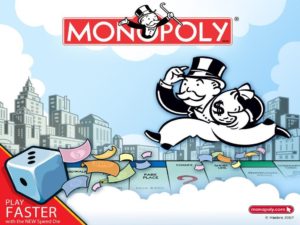 The origin of Monopoly, the most popular board game in modern history, is ironically descriptive of the current “land grab” in Phillips at 25th Street and Park and Columbus Avenues. Monopoly players indulge in cutthroat, ruthless, and greedy impulses. Players begin the game as equals. Monopoly was the product of a passion for social and economic justice.
The origin of Monopoly, the most popular board game in modern history, is ironically descriptive of the current “land grab” in Phillips at 25th Street and Park and Columbus Avenues. Monopoly players indulge in cutthroat, ruthless, and greedy impulses. Players begin the game as equals. Monopoly was the product of a passion for social and economic justice.
In 1904 Elizabeth Magie designed a board game to demonstrate the tragic effects of land-grabbing; oligarchs enrich themselves at the expense of tenants, the latter grow poorer as available land decreases and rent increases. The poorer the proletarian player gets, the more he or she is squeezed; there is nowhere to go that doesn”'t demand a fee of some kind, and there is no respite. The game ends only when everyone is driven penniless into the ground, but for a single aristocrat who now owns everything. She named it The Landlords”' Game. Coincidentally she married Albert Phillips in 1910.
In Phillips, we have non-profit institutions indulging in “cutthroat, ruthless, and greedy impulses” in real life. They do not contribute to public revenue with taxes but are exempt from taxes. They do healthcare (albeit less to local people than regional patients with more ability to pay) and evangelism; but neglect the local community while their impacts take away from neighbors.
This model of land ownership began in the United States as land acquisition through conquest and abrogated treaties with Native American Indians centuries ago forged land ownership to white landlords.
Adding insult to injury histories and art have kept the truth silent by altering stories, omitting true facts, and falsified oil painting portrayals at the State Capitol and elsewhere [see page 1].
Disallow these “wolves in sheep”'s clothing” to continue their blight on our Community only to advance their own prestige and finances. Don”'t let the missions and pleas of a hospital and religious community, “pull the wool over our eyes!”
Children”'s MN has devastated housing on more than two city blocks. Ten years ago they demolished 26 homes, a church, and an auto service station surreptitiously (including silent acquiescence by another property holding non-profit, tax exempt institution dedicated to housing and employment who parlayed their land sale to building excellent headquarters on Franklin Ave.).
Children”'s MN is now seeking to complete that onslaught by buying the Messiah Church property on E. 25th Street after the Messiah Congregation has agreed to demolish their former sanctuary for them.  Messiah Church was designed by Harry “Wild” Jones, one of the foremost architects in America, who also designed the H.V. Jones (no relation to Harry “Wild” Jones) mansion at 2501 Park Ave. demolished by Messiah Congregation in 1952. Children”'s offer to buy also includes the Messiah property between Columbus and Park Avenues that is more than half of that block including the building now leased by Augsburg Fairview Academy.
The expert consultants and public relation artists of artifice and political chicanery hired by Children”'s and Messiah can be very influential and even more effective “behind closed doors” at banks and City Hall.
Messiah Congregation is “between a rock and a hard place” because they have extreme expenses being a “partner” renter at the LSS 2400 Park Avenue Center for Changing Lives. Children”'s MN is desperate to embellish their opulence to compete better in healthcare with amenities.
Both of these institutions granted non-taxed benefits have “changed our lives” with their “Monopoly” transactions and owe our Community the benefit of having this development discussed publicly and not silently behind corporate doors.
Lest their “experts” opinions stand alone, consider these alternative opinions of other noted experts quoted in The Power of Place: Urban Landscapes as Public History by Dolores Hayden.
“”˜The relationship between history and memory is peculiarly and perhaps uniquely fractured in contemporary American life,”' writes public historian Michael Frisch. His colleagues, Jack Tchen and Michael Wallace, observe, ”˜historical amnesia”' and ”˜historicidal”' culture. Urbanist M. Christine Boyer writes of architectural history manipulated for commercial purposes. Geographer David Lowenthal wryly calls the past a ”˜foreign country.”' Citizens surveyed about history will often speak disparagingly of memorized dates, great men, ”˜boring stuff from”' disconnected from their own lives, families, neighborhoods, and work. And certainly there are many people for whom the past is something they want to escape. Yet every year tens of millions of Americans travel to visit historic sites and museums (including some of doubtful quality), as well as historically oriented theme parks and ”˜theme towns.”' If Americans were to find their own social history preserved in the public landscapes of their own neighborhoods and cities, then connection to the past might be very different.”
The silence of deception, manifest destiny hubris, and revisionist history and art produce deafening sounds over time.
“Read the writing on the wall.” Don”'t allow the “neon lights” on the street or in hospital rooms distract you from telling your stories to each other and on the urban landscape.









